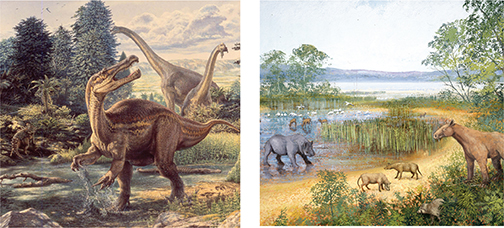Figure 37 The two most recent eras of Earth's history are the Mesozoic Era and the Cenozoic Era. A During the Mesozoic Era, dinosaurs such as Baryonyx (center) and Brachiosaurus (right) roamed Earth's surface. B During the Cenozoic Era the diversity and size of mammals increased greatly.
 d
dCenozoic Era: 65 Million Years Ago to the Present
Since the end of the Mesozoic Era, Earth has been in the Cenozoic Era. During this time, Earth's climate has generally become cooler and drier. Several ice ages have come and gone in the last 5 million years.
Although small mammals existed during the Mesozoic Era, mammals became very diverse and widespread during the Cenozoic Era. Some of these mammals, like those in Figure 37B, were much larger than modern land mammals. About 150,000 years ago, modern humans first appeared in Africa. Since then, humans have migrated to every continent. Today, humans are the dominant form of life on Earth. They have a significant influence on Earth's environments.
Section 23.6 Assessment
Reviewing Concepts
 What evidence do geologists use to determine the relative age of rocks?
What evidence do geologists use to determine the relative age of rocks? How can the absolute age of a rock be determined?
How can the absolute age of a rock be determined? What types of information did geologists use to develop the geologic time scale?
What types of information did geologists use to develop the geologic time scale? How does the geologic time scale divide Earth's history?
How does the geologic time scale divide Earth's history?What is one hypothesis about the cause of the dinosaurs' extinction?
Critical Thinking
Inferring Geologists in two widely separated locations find rocks that contain fossils of an extinct organism that lived for only a brief time. What can the geologists conclude about the ages of the rocks?
Drawing Conclusions Using radioactive dating, geologists determine that a layer of igneous rock from a lava flow is 60 million years old. What can you conclude about the age of a layer of sedimentary rock that lies just below the igneous rock? Explain.
Math Practice
A fossil contains 10.0 milligrams of radioactive carbon-14. How much carbon-14 will remain after two half-lives?
How long will it take for the amount of potassium-40, which has a half-life of 1. 3 billion years, in a rock to decay from 50. 0 milligrams to 12.5 milligrams?




